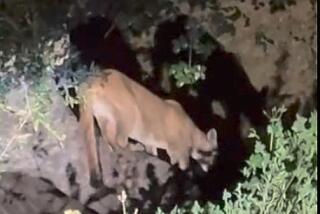Wildcat shows Japan’s new ties to nature
- Share via
IRIOMOTE NATIONAL PARK, JAPAN — The steamy, hazy jungle thrums with trilling insects, singing frogs and the steady gurgle of rushing water as we cut through thickets of head-high ferns.
Prowling out there in the emerald underbrush is the big prize of our safari -- one of the planet’s rarest wildcats.
A cat so rare that it was discovered only in 1965. So threatened that only about 100 exist. So singular that it lives only on this 110-square-mile Pacific island. Yet the elusive Iriomote cat is more than just an endangered species.
Efforts to save it from extinction symbolize a change in Japan’s relationship with nature. Not only does the struggle underline the country’s determination to redress decades of environmental devastation at the hands of unbridled industrialization, it proves how tough reversing the damage can be.
“The wildcat’s barely hanging on,” said jungle guide Maki Okamura, a scientist at the Environment Ministry’s Iriomote Wildlife Conservation Center. “Even if we lose just one, it has a huge impact.”
Spotting an Iriomote wildcat will be a long shot, not just because it has nearly died out.
The mottled, dark brown cat with its rounded, club-like tail is the size of a house tabby, and the jungles of its namesake island are nearly impenetrable. But Okamura knows every fold in the forest and routinely stops to hunt for footprints, scat and other telltale signs as she blazes through the dank mangrove swamps, keeping one eye out for cats, the other for deadly Okinawan vipers.
One of Japan’s southernmost points, coral-fringed Iriomote lies closer to the Philippines than to Tokyo and is known as Asia’s Galapagos for its primeval tropical forests and one-of-a-kind wildlife.
The wildcat’s scientific name -- Prionailurus Iriomotensis -- certifies its local roots, where it evolved as an isolated offshoot of mainland Asia’s so-called leopard cat, another small wildcat unrelated to the true leopard.
For most of that time, outsiders steered clear of Iriomote’s malarial swamps.
But after World War II, sugar cane farmers and cattle ranchers moved in -- as did scientists curious about sightings of a strange yamaneko, or “mountain cat.”
The discovery gave Japan a rare chance to redeem a dismal conservation record.
Wolves are one of four mammals to have disappeared in Japan’s breakneck industrial development, while the crested ibis and red-crowned crane are all but extinct. Short-tailed albatrosses were nearly hunted into oblivion for their feathers. Then came Japan’s commercial whaling binge.
Japan set up an environment agency in 1971, but it took another 20 years to get an endangered species list. Meanwhile, 47 animals died out for good. Another 303 are on the brink.
“Things are getting better, but there’s still a long way to go,” said Hidenori Kusakari, a lobbyist for the World Wildlife Fund in Japan, whose uphill job is winning nature-friendly legislation.
In recent years, environmentalists have won lawsuits against polluters and blocked development plans that threaten sensitive habitats throughout the country.
The Iriomote cat is the big test.
“We still have time to save it,” Okamura said.
Designated a Special Natural Living Monument by the government, the cat is a mascot for environmentalism throughout the southern island chain of Okinawa, where its image is on city buses, refrigerator magnets, key chains and coffee mugs. There are even wildcat stuffed animals -- and chocolates shaped like wildcat poop pellets.
Despite that few humans ever see it, the cat’s existence has brightened Iriomote’s aura as an unspoiled paradise and helped draw a flood of nature lovers, scuba divers and big-city transplants.
The number of tourists has jumped 14-fold from 1975 to about 700,000 people a year -- putting new stresses on an island with 2,200 permanent residents, one main road, two stoplights and no high school.
Things got worse for the cat. Habitat loss, interbreeding with house cats, the spread of new diseases, stray dogs and the introduction of crab traps have all pushed up mortality rates. Traffic is the No. 1 killer, flattening one or two cats a year.
The island’s sprawling national park preserves much of the mountainous interior, but it doesn’t cover the cat’s prime lowland habitat along the coast -- where people are settling in droves.
Okamura’s wildlife center is fighting back with a number of innovative projects, including photo traps to catalog each cat, radio tracking to find their ranges and a rehabilitation center with a 24-hour hotline to report cats hurt in road accidents.
The single cat recuperating today is W-48, named for the island quadrant where it was hit by a car. In the island rehab center, it is monitored through a video camera to spare it the tension of human interaction.
“It’s really a model program for others around the world,” said Jim Sanderson, a small-cat expert at Conservation International who has visited Iriomote.
Perhaps Iriomote’s most stunning project is its so-called Eco Road, a two-lane highway encircling half the island.
Along its winding stretches, cat-crossing signs punctuate the jungle green and 80 cat underpasses run beneath the pavement.
Shots from camera traps suggest the population has dropped substantially from the estimate of 100 about 12 years ago. But the center said it lacked the money to carry out a census that would determine whether the conservation effort was working.
A day trudging through the jungle offered its own discouraging testimony.
Early on, Okamura guided us to a remote photo box where a picture of a cat was snapped a week before. But no sign of cats. Then to a stream where the animals come to ambush birds, snakes and other prey. Nothing.
Next to a cat-friendly rice paddy where delicious frogs abound. Not even a footprint.
Same at a hollow tree, perfect for cats wanting to lounge on a branch and beat the summer heat.
By dusk, a steady downpour had silenced the darkening jungle. That was when we realized that the grainy video images of W-48 dozing in the rehab center would be as close as we ever got to the real thing.
More to Read
Sign up for Essential California
The most important California stories and recommendations in your inbox every morning.
You may occasionally receive promotional content from the Los Angeles Times.













